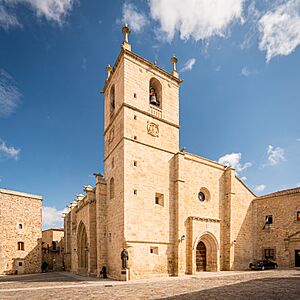Co-Cathedral of Cáceres facts for kids
Quick facts for kids Cáceres Co-Cathedral |
|
|---|---|
| Co-Cathedral of Saint Mary | |
| Concatedral de Santa Maria | |

North-west view in 2023.
|
|
| 39°28′28″N 6°22′12″W / 39.4745°N 6.3701°W | |
| Location | Cáceres |
| Country | Spain |
| Denomination | Catholic |
| History | |
| Status | Co-Cathedral |
| Dedication | Mary, mother of Jesus |
| Dedicated | 9 April 1957 |
| Architecture | |
| Style | Late Gothic |
| Years built | 15th—16th Centuries |
| Administration | |
| Metropolis | Mérida-Badajoz |
| Diocese | Coria-Cáceres |
The Co-Cathedral of Saint Mary is a very old and important Catholic church in Cáceres, Spain. It's called a "co-cathedral" because it shares its main role with another cathedral. This means it's one of two main churches for the Diocese of Coria-Cáceres. It became a co-cathedral on April 9, 1957.
This amazing building was mostly built in the 15th century. It shows off a style called Gothic, which is known for its tall arches and detailed carvings. The main entrance, however, has an older style called Romanesque. Since 1986, the co-cathedral and the entire Old Town of Cáceres have been recognized as a UNESCO World Heritage Site.
Contents
What is a Co-Cathedral?
A co-cathedral is a special type of church. It serves as one of the main churches for a diocese, which is an area managed by a bishop. Usually, a diocese has just one cathedral. But sometimes, like in Cáceres, it has two. This means the Co-Cathedral of Saint Mary shares its important duties with the Cathedral of the Assumption of Our Lady in Coria.
A Glimpse into History
The Co-Cathedral of Saint Mary has a long and rich history. Its construction began in the 15th century and continued into the 16th century. This makes it hundreds of years old! The builders used the popular Gothic style of that time, which you can see in its tall, pointed windows and strong walls. The main entrance, or portal, was built in the Romanesque style, which is even older. This mix of styles makes the building very unique.
Amazing Art and Sculptures Inside
Step inside the Co-Cathedral, and you'll find incredible artworks. One of the most important pieces is the main retablo, or altarpiece. It was created in the 16th century by artists Roque Balduque and Guillen Ferrant. This large, decorated screen behind the altar is dedicated to the Assumption of the Virgin. It tells stories through its detailed carvings. You can also see other beautiful sculptures, including a famous one of San Pedro de Alcantara by Enrique Pérez Comendador. These artworks help tell the story of the church and its history.
A UNESCO World Heritage Site
The Co-Cathedral of Saint Mary is part of something even bigger: the Old Town of Cáceres. In 1986, this entire historic area was named a UNESCO World Heritage Site. This means it's considered very important for everyone in the world to protect and enjoy. UNESCO recognizes places that have special cultural or historical value. The co-cathedral is a key part of why Cáceres is so special.
See also
 In Spanish: Concatedral de Santa María (Cáceres) para niños
In Spanish: Concatedral de Santa María (Cáceres) para niños

